
Andy Lloyd's Dark Star Blog

Blog 20 (November 2014)
The Mystery of Comet 67P
It's taken a heck of a long time, but finally the 10 year ESA Rosetta mission has successfully deployed its Philae lander onto the surface of Comet 67P/Churyumov–Gerasimenko (1). Philae bounced a few times during the arduously long landing (which was more like a highly sensitive docking procedure due to the almost complete lack of gravity on the comet). Perhaps this will make the Guinness Book of Records for the longest landing in history? Even if the lander has a short shelf life due to the crater wall shadow it now finds itself in, we should still discover a lot more about the composition of comets (2), and thus the conditions of the early solar system.
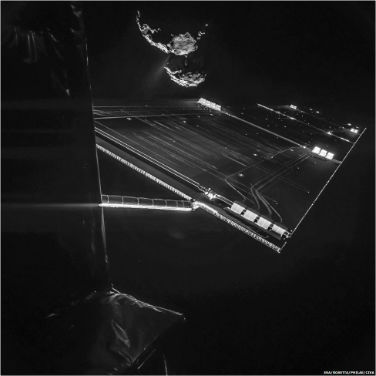
Comet 67P as seen from the Rosetta spacecraft (3)
Comet 67P is a short period Jupiter-class comet with an orbital period of 6.45 years (3). Unlike the long-period comets, which enter the solar system from the Oort Cloud or beyond, this comet is now very much at home among the planets, having had its orbit affected by a close pass with Jupiter in 1959 (4). Presumably, at some point in the past it came into the planetary zone from beyond, as an outer period comet. It has been thought for a long time that the Earth's water originated from comets. The argument goes that the Earth's relatively close proximity to the Sun means that its early water should have been driven off with the other volatiles, burned off the primordial surface of the Earth by the Sun's heat. Yet, the Earth is covered in oceans, providing something of a mystery which Comet 67P may help to solve.
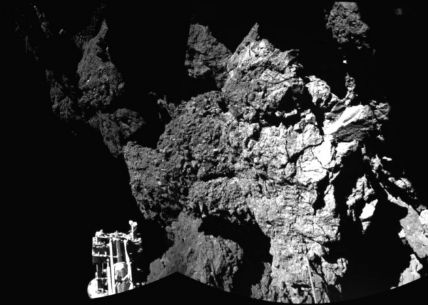
ESA's image of the Philae Lander on Comet 67P (1)
Around 3.9 billion years ago, there was a prolonged and heavy bombardment of enormous comets (or something enormous, anyway) that pummelled the Earth, and other planets and moons in the inner solar system. It is thought that this event, as well as the arrival of other comets over billions of years, provided the Earth with its veneer of water. If that's the case, then it follows that the properties of the water (i.e. the isotopic ratio between H2O and D2O) on Earth should be similar to that of the long period comets arriving from the Oort Cloud. That assumes that the water from the comets have roughly similar isotopic properties to each other, which would be reasonable if one assumes that the comets formed initially from the Sun's primordial disk and then spread out into the Oort Cloud beyond. However, that's not the case, which has brought this 'late veneer theory into question, as discussed in this article written by staff at the European Space Agency about their Herchel space laboratory:
"All comets previously studied have shown deuterium levels around twice that of Earth's oceans. If comets of this kind had collided with Earth, they could not have contributed more than a few percent of Earth's water. In fact, astronomers had begun to think that meteorites had to be responsible, even though their water content is much lower.
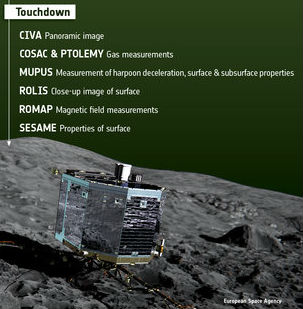
Instruments on the Philae lander and the science expected (2)
"Now, however, Herschel has studied comet Hartley 2 using HIFI, the most sensitive instrument so far for detecting water in space, and has shown that at least this one comet does have ocean-like water. "Comet Hartley's deuterium-to-hydrogen ratio is almost exactly the same as the water in Earth's oceans," says Paul Hartogh, Max-Planck-Institut für Sonnensystemforschung, Katlenburg-Lindau, Germany, who led the international team of astronomers in this work." (5)
One of the first findings from Philae should be the comet's water composition, courtesy of the Ptolemy instrument:
"One of the ten instruments aboard the Philae lander is Ptolemy; a miniature chemical analysis suite designed and built in the UK. The 4.5kg instrument will provide chemical and isotopic analyses of both volatiles (including water) and refractory materials drilled from comet nucleus, and will also conduct the same analyses on volatile compounds collected from the cometary coma." (6)
Perhaps Comet 67P will have water like Hartley 2, or perhaps more like the other comets whose isotopic ratio of water has been determined. But there's another issue here that is not being address, that is literally staring us in the face.
The other major assumption at play here is that comets are 'dirty snowballs'. But the most cursory look at Comet 67P from the Rosetta spacecraft indicates that it looks more like a standard asteroid. Now we have imagery of the the surface from the Philae lander, and that looks even less like a dirty snowball. In fact, it looks more like the lander is sat in a quarry. There's no ice in sight!
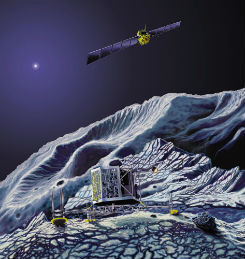
Official Artist Impression 2006, Credit: Astrium/Erik Viktor (6)
Now, you might argue that this short period comet has been through its perihelion pass enough times for its ices to have been driven off by the Sun's heat. But, that was not the expectation when Rosetta was first sent. In an Open University paper based upon a lecture given at a planetary science conference in Texas in 2006 (6), the official artist's impression of Philae and Rosetta shows a comet surface which is covered in ice and snow (image above). Such an image reflected the 'dirty snowball' view of the composition of comets widely held at the time.
Author Al Cornette has pointed out how the Philae lander's harpoon system also indicates what was assumed about the surface of the comet when the mission was in the design stages - that there would be plenty of ice to attach the harpoon to when stabilising the lander's position (7). Instead, the comet looks more like a barren rock, one impervious to the harpoon's attentions. Its coma must presumably be sourced from ices within, sublimating during perihelion and violently emerging from the comet in a process known as 'outgassing'. This is in keeping with findings of comet Hartley 2, where outgassing of volatile carbon dioxide spews water ice out into space (8).
Here's the thing. If comets turn out to be small rocky worlds whose store of volatile ices make a very spectacular but short-lived show during perihelion, then it's very hard to see how they could have delivered enough water to the Earth to fill our oceans... They simply don't have enough water on board to do the job. That's above and beyond the issue created by the mismatch of isotopic ratios between earth and most of the comets analysed.
The implication of this is that the Earth already had its water when it first formed. As we shall see in the next item, that is a realisation that is now taking hold in the scientific community. So, how is it that early Earth water was not removed by the the bombardment of the solar wind? Perhaps the Earth had a lot of water below the surface, which escaped the fate of the surface volatiles - but it would have had to have been a awful lot of water down there! Some geologists argue that astronomers have it all wrong, and that this is what really happened (9).
Or, perhaps the Earth was not at that time located so close to the Sun, thereby allowing it to keep its water in a cooler zone.
This is the creation story which Zecharia Sitchin has provided us with, based upon his reading of the ancient Sumerian texts (10). The Celestial Battle between the emergent, resplendent god Marduk and the watery monster Tiamat, as described in the Babylonian Enuma Elish (11), can be understood in cosmological terms as a description of a catastrophic event in the early solar system. Tiamat was the early Earth, a then larger world, covered in water, which was located where the asteroid belt is now. Marduk was a seething red planet of enormous proportions (likely a sub-brown dwarf, or Dark Star (12)) which crashed through the solar system in a similar way that comets do. It either directly impacted or caused a collision between one of its moons and Tiamat, causing the watery world to fracture, shedding its waters across the solar system and deflecting the main planetary remnant into the inner solar system, thereby becoming the Earth.
Many of my readers will be familiar with this story, along with its various scientific implications. The reason I repeat it here is to emphasis the last part - the shedding of Tiamat's waters. The scattered debris from the fractured world became the asteroid belt (the Hammered Bracelet in the Babylonian epic) and also, of most importance here, the comets... Which means that according to Sitchin's 12th Planet Theory, the origin of Comet 67P, like Comet Hartley 2, might have actually been the early Earth! It is, as one might say, a chip off the old block. As strange as this may all seem, it does make sense of the complex picture emerging from scientific analyses of the composition of the comets, and their relationship with the waters of Earth.
So, as with Hartley 2, we might find ourselves in the curious position of finding out that the comet Rosetta is orbiting around does indeed share its water with Earth. However, the lack of an abundance of cometary water, as seen in the images of these comets, implies that they are not dirty snowballs as previously thought, and that the late veneer theory is therefore found wanting. Not only do most comets not have the correct isotopic signature, but those that do don't hold enough of the stuff to fill the oceans.
Frankly, scientists have been looking the wrong way down the telescope on this subject. Rather than the comets giving water to the Earth, it seems increasingly likely that the Earth gave birth to some of the comets. And, as we shall see next, the asteroids seem to share a similar origin.
Written by Andy Lloyd, 14th November 2014
References:
1) James Vincent "Rosetta images: Philae sends back first ever picture from the surface of comet 67P" 13 November 2014
2) "ESA Confirms the Primary Landing Site for Rosetta" 15 October 2014
3) Jonathan Amos "Rosetta mission: Philae comet lander pictures its target" 14 October 2014
4) "67P/Churyumov–Gerasimenko"
5) ESA "Did Earth's Oceans Come From the Comets?" with thanks to Lee
6) Dan Andrews et al. (2006). "Ptolemy: An instrument aboard the Rosetta lander Philae, to unlock the secrets of the solar system." In: 37th Lunar and Planetary Science Conference, 13-17 March 2006, Houston, Texas, USA.
7) Correspondence from Al Cornette, 14 October 2014
8) "103P/Hartley"
9) Andy Lloyd "Oceans of Water Trapped inside the Earth" 15 June 2014,
andylloyd.org/darkstarblog15.htm
10) Zecharia Sitchin "The Twelfth Planet" Avon, 1976
11) Enuma Elish, The Epic of Creation Translated by L.W. King
12) Andy Lloyd "Dark Star: The Planet X Evidence" Timeless Voyager Press, 2005, pp80-1
The Early Watery Planet
Water, water, everywhere... Is it possible that the early Earth was completely covered with deep oceans of water? Consider Jupiter's Galilean moons, Europa, Callisto and Ganymede. These perfect billiard balls appear to comprise of a spherical ice exterior under which lurks oceans internally warmed by the gravitational influence of the nearby gas giant. If Jupiter was brought closer to the Sun, then these moons would develop their own atmospheres, and their global ice caps would melt way, leaving global seas. Not unlike Kevin Costner's "Waterworld", that well known disastrous disaster movie. Might have earth once have appeared the same?

Scientists are coming around to the idea that the Earth was born with its own water already in place. It makes sense in many ways, because the composition of the primordial disk of matter circling the Sun in its infancy was likely full of water. The rock that was the early Earth was born into the birthing pool, and became immersed in it as it coalesced and cooled. This is an hypothesis that was historically rejected because scientists thought that these waters should have been driven off by the early Sun's heat and the action of the solar wind (as well as the violent collisions commonplace in the early solar system), leaving the early Earth a dry, barren place, which later collected its waters from impacting comets. But, as we have seen in the article above, there are an increasing number of problems with this 'late veneer theory'; opening the door for a total rethink. Now, a new study involving primitive meteorites known as carbonaceous chondrites has significantly moved back the clock for the first evidence of water on Earth and in the inner solar system (1). These rocks are heavy with water, and are as old as the solar system itself, leading to reasonable speculation that they were a central building block of the rocky planets, moons and other bodies:
""The study shows that Earth's water most likely accreted at the same time as the rock. The planet formed as a wet planet with water on the surface," said Horst Marschall, a geologist at Woods Hole Oceanographic Institution [WHOI] and co-author of the paper. One school of thought was that planets originally formed dry, due to the high-energy, high-impact process of planet formation, and that the water came later from sources such as comets or "wet" asteroids, which are largely composed of ices and gases. "With giant asteroids and meteors colliding, there's a lot of destruction," said Marschall. "Some people have argued that any water molecules that were present as the planets were forming would have evaporated or been blown off into space, and that surface water as it exists on our planet today, must have come much, much later—hundreds of millions of years later." (2)
The presence of water on the Earth has effectively been set back to a point 135 million years earlier than previously thought. That creates a problem for planetary scientists who now need to explain how the Earth managed to hold onto its water:
"The jump back in time is significant, says [Adam] Sarafian [a Ph.D. student at the MIT/WHOI], because during those first 150 million years, the inner solar system was considerably hotter and more hostile than it was later on. Earth would have experienced major impacts from flying debris (it was potentially such an impact that broke off a portion of the Earth and formed the Moon). Many scientists have suspect that through those big impacts and high temperatures, it would make sense for the hydrogen to turn into vapor and be blown out into space. "The planets held on to the water somehow," Sarafian said. "That's going to make people rethink how planets are made."" (3)
So, does this mean that the Earth had a bit of water which somehow managed to survive the furnace; or was the early Earth simply covered in a truly immense ocean of water and had plenty to spill when disaster struck, as it so often did back then? You can bet that most mainstream scientists will opt for the former, as it is closest to the previously held theory. But surely the water-world scenario makes more sense? The following comment from Science implies the same:
"Sarafian hoped to see if the water in eucrites shared a common origin with water on Earth. Planetary scientists track water in the solar system by measuring the amount of deuterium, a heavy form of hydrogen. If two samples have similar ratios of deuterium to regular hydrogen, then the samples’ water probably came from the same place. Sarafian’s team reports in the Oct. 31 Science that the deuterium-to-hydrogen ratio in the eucrites, and by extension Vesta, closely matches the ratio in Earth’s oceans. The similarity means Vesta and Earth have a common source of water. And because Vesta formed before Earth, that water was available when the planet started taking shape. “Earth wasn’t waiting for water,” Sarafian says. Instead, it seems, the water was waiting for Earth." (4)
A quite different and similarly thought-provoking issue arises out of the WHOI study. It turns out that the Earth's carbonaceous chondrites share the same hydrogen to deuterium isotopic ratio as meteorites from the asteroid 4-Vesta, as is clear from this article in the Daily Galaxy:
"The asteroid 4-Vesta, which formed in the same region of the solar system as Earth, has a surface of basaltic rock—frozen lava. These basaltic meteorites from 4-Vesta are known as eucrites and carry a unique signature of one of the oldest hydrogen reservoirs in the solar system. Their age—approximately 14 million years after the solar system formed—makes them ideal for determining the source of water in the inner solar system at a time when Earth was in its main building phase." (2)
This is all very well, until you examine the phrase "which formed in the same region of the solar system as Earth" (2) in any sort of detail. Many readers will realise that 4-Vesta is the second biggest asteroid in the solar system, residing comfortably in the asteroid belt between Mars and Jupiter. It is considered to be the last remaining rocky protoplanet of the kind that formed the terrestrial planets (5), and is thought to have formed before the Earth.
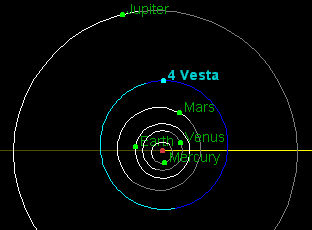
How curious, then, that it should exhibit exactly the same isotopic hydrogen/deuterium ratio in its carbonaceous chondrites as the Earth! Is it strictly correct to claim that the Earth and Vesta formed in the same region of the solar system? Only in the broadest of terms - through a simple differentiation between the inner and outer solar system. If I was to be pedantic about it, which I am liable to be, I would point out that the Earth is not actually in the asteroid belt. It's not right to say that these two bodies formed in the same region - at least, not according to the mainstream thinking about the origin of the solar system, anyway. Yet, that's what the scientific finding implies. The author of the Daily Galaxy article is brushing over this tricky problem, as might be expected when the data creates an uncomfortable anomaly. Furthermore, why would they have the same isotopic ratio if the Earth and 4-Vesta formed at completely different times in the history of the solar system? Surely the conditions of planetary formation would have changed over time? All we can really assert here is that the common isotopic ratio implies a common origin, which in the maelstrom of the early solar system implies a greater degree of intimacy than scientists are currently willing to consider.
So, one might draw a rather more interesting conclusion from this finding than the realisation that the early Earth was a water-world, as fascinating as that might be. That is, the origin of Earth and 4-Vesta were actually directly connected. They were both, quite possibly, part of the strewn debris field of the mythical planet Tiamat, rended asunder by its calamitous encounter with the Dark Star some 3.9 billion years ago. I suggest that this latest science adds to the growing database of evidence supporting such a scenario.
Written by Andy Lloyd, 28th November 2014
References:
1) A.R. Sarafian et al. "Early accretion of water in the inner solar system from a carbonaceous chondrite-like source", Science, 346(6209): 623-626, 31 October 2014
2) ""Earth Formed as a Wet Planet with Oceans in Place" --Life May Have Started Earlier Than Thought" 31 October 2014 (article no longer available online), with thanks to Lee
3) Calla Cofield "Earth's Water Existed 135 Million Years Earlier than Thought" 30 October 2014, with thanks to Lee
4) Christopher Crockett "Water arrived on Earth earlier than thought" 1 November 2014 with thanks to John
5) "4 Vesta"
A Mysterious Gnostic God
An ancient site in Turkey, close to the Syrian border, has turned up a surprising new archaeological discovery - a previously unknown and rather bizarre looking god set in bas relief.
"The relief was first discovered at the site of the Jupiter Dolichenus temple in southeast Turkey, near the border with Syria. The city, Gaziantep, has been continuously occupied for thousands of years, and has long sat at the crossroads of many cultures, from the ancient Hittites to the Arameans." (1)
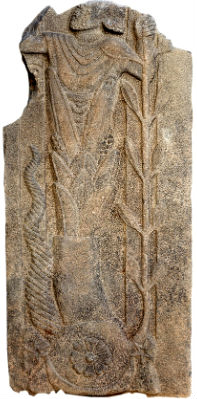
While the figure's torso has a Romanesque feel to it, implying Jupiter Dolichenus (in keeping with the temple at the archaeological site), or perhaps even Mithras emerging from rock, the accompanying symbolism harks back to ancient Mesopotamia. In particular, the god appears to emerge from a melange of symbols, including a trinity of crescent moon, Sun-rosette and 6-pointed star. The juxtaposition of crescent and Sun is often seen in symbolic imagery associated with Baal-Hadad (a Middle Eastern Canaanite god from 2nd Millennium BC Syria), or the even older Mesopotamian sun-god Shamash.
This symbolism clearly pre-dates and seems to have been influential in the emergence of the Star and Crescent of Islam (although the accompanying star seems to have been dropped).
Curiously, though, the celestial imagery is to be found at the god's feet rather than in the sky above him. Even more curiously, the god appears to be emerging from some kind of exotic plant-life or perhaps even half-man/half-fish imagery in keeping with the Babylonian god Oannes described by the priest Berosus. Alternatively, is the god depicted as a Naga, the Hindu serpent deity? This serpent-god answer seems the most plausible to me, as one might imagine his flowing serpent like body flowing around to the snake-like tail to the immediate left of the central figure. Often, the astrological symbols here are associated with a large serpent in Babylonian motifs, again implying a Mesopotamian origin for these symbols.
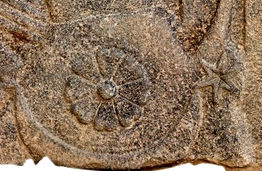
Photo credit: Peter Jülich
There's great uncertainty here, and, to be honest, your guess is as good as mine when trying to unpick this bizarre gnostic creation. But just to add a little further speculation to the mix, the astrological symbolism deployed here can also be alternatively interpreted as a quixotic celestial event. That is, the symbolism depicts an anomalous event in the sky whose central importance provided impetus to project it down through the generations of ancient history - the appearance of an aura-wrapped, almost comet-like Planet X and one of its main moons.
In which case, the monstrous god central to this mysterious motif is closely associated with the appearance of this 'Dark Star' event might be better understood as one of the Anunnaki, this time with a distinctive Roman countenance, emerging from the arriving celestial ferry Nibiru.
Written by Andy Lloyd, 28th November 2014
References:
1) Tia Ghose "Photos: A Mysterious Roman God" 25 November 2014, with thanks to Lee
Correspondence about Pole Shifts
Hi Andy,
Besides a possible binary star to our sun is there anything else that could feasibly have caused pole shift here on earth in the past. Science has proven the Earth has gone through pole shift right . Multiple times. If people don't want to believe that then what did cause past pole shifts, proven pole shifts if not the binary twin to our own sun.
Ranssom Nichols (correspondence received 25th November 2014)
~~ * ~~
Hi Ranssom,
So, pole shifts - the magnetic poles shift about constantly, as I'm
sure you're aware, and there are a great many localised disturbances
in the Earth's magnetic field. Every so often, as you say, there's
a total swing about from north to south, and I guess the reason for
that is mysterious. So, perhaps a major solar event causes a large
magnetic disturbance in the solar system's overall magnetic field -
a redistribution of the 'neutral sheet' has been suggested before
now. This might then create a realignment of Earth's own field.
Or maybe the iron core at the centre of the Earth swings around like a ball internally, taking the magnetic field with it.
Or perhaps the movement of a Dark Star binary companion or massive Planet X through the solar system might cause a realignment if the object were to pass relatively close to the Earth.
Or maybe something totally off the wall, like Charles Hapgood's crustal displacement theory, whereby the Earth's crust periodically twists about (again, maybe because of a local cosmic gravitational disturbance) creating the dynamic where the magnetic field stays in the same place (because the core is unmoved), but the crust swings around. The upshot of this would be that there appears to have been a reversal of the magnetic pole, but actually there was a tumultuous shift of the Earth's crust towards 180 degrees merely creating that appearance, with respect to the local recorded magnetic patterns on the surface. This is a daring, if slightly potty theory, but Einstein liked it, so I guess it might have some traction after all.
Andy Lloyd
Enigmatic Art Points to Ancient Extraterrestrial Visitors
My good friend Martin sent me this link to a rather enigmatic series of drawings and artwork found in an old case in a dumpster recently in the U.S. Knowing my interest in the Book of Ezekiel (featuring in the title of my novel 'Ezekiel One'), he knew I would find the content of this suitcase fascinating. The strange mix of material reminds me a little of the mysterious Voynich manuscript, although this more contemporary set of artwork is more grounded than that. Except for the extra-terrestrial drawings, perhaps, which are imaginative and reasonably skilled in their draughtsmanship.
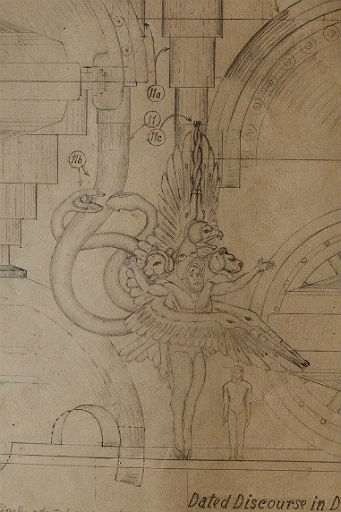
It's a shame that the artist did not share his/her work during their lifetime - the collection seems to have been thrown out as part of a house clearance. One of the drawings is dated to 1939, and the artist seems to have a strong scientific or engineering background. Their interest in UFOs, and accompanying angels/extraterrestrial visitors seems to have been triggered by an encounter in the 1960s, an account of which is included in the collection. Check out the links below for the images themselves.
Written by Andy Lloyd, 28th November 2014
Reference:
1)
Eddie L. "One Man Found a Mysterious Box in a Dumpster – What Was in it Was Absolutely Baffling" with thanks to Martin

You can keep informed of updates by following me on Twitter:
![]()
Or like my Facebook Page: https://www.facebook.com/darkstarandylloyd